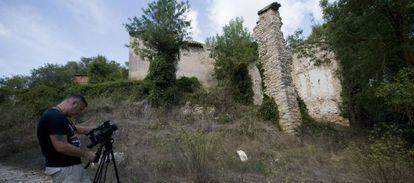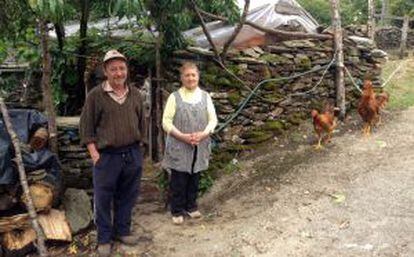For sale: your own Spanish village
The idea of owning an entire hamlet has proved attractive to many, but rarely becomes a reality

Pavel digs his tripod into the mass of thickets and ruins that was once Esblada, a village in Tarragona that is now up for sale. Pavel and a reporter from Russian television are preparing a documentary on a phenomenon that has attracted international attention: the sale of small rural communities like this at knockdown prices in a country mired in an economic crisis that shows little signs of recovery and where people continue to abandon the countryside. Around 3,000 villages are up for sale: for some they are an investment opportunity; for others, the chance to start a new life.
Documentaries about Spain’s deserted villages have been shown all over the world, prompting enquiries from as far away as Australia. Britain’s Daily Mail newspaper reported in May that it was possible to buy a village in Spain for the same price as a garage in London. But for the moment, despite the interest from overseas, there have been few sales: buyers hoping for a bargain have instead come up against red tape, building costs, and banks reluctant to lend.
The Daily Mail reported that you can buy a village in Spain for the same price as a garage in London
“We receive around 150 emails a day, most are about buying a village,” says Elvira Fafián, the manager of aldeasabandonadas.com, a website that pretty much controls the market in abandoned villages. She says around 70 percent of enquiries are from foreigners. “In 2014 there has been strong demand. We can’t keep up. This is a boom.” The majority of would-be customers come from Switzerland, Germany, Mexico, Russia, China and the United States. Fafián says there is a widespread perception that the crisis in Spain has sent property prices plummeting and that now is the time to buy. The majority of the 100 or so villages Fafián has for sale range in price from around €60,000 to €2 million.
Together the 14 properties that make up Esblada, once a rural idyll set against the dramatic backdrop of the Ancosa mountains, but today little more than pile of stones entwined with rockroses, are on sale for €280,000. Two main streets and a couple of squares can just be made out under the tangle of vegetation: the community’s last residents left in the 1960s after a small insecticide factory closed and charcoal production was industrialized.
Esblada highlights the problems of selling a village. The prices may be bargain basement, but the cost of rebuilding houses can be several times that of purchasing them. And when foreigners come looking, the first thing they do is start adding up the costs. At the moment, a Chinese buyer is interested, as is a group of young locals. The seller is a bank that embargoed the community after its former owner tried and failed to set up a rural tourism business.

There aren’t many figures available for a market that is characterized by opacity, but it seems clear that while the purchase of all types of property by overseas buyers has hit a historic high in the first half of this year, there are few takers for whole villages. Fafián says she sells “one or two” communities a year, but refuses to give any details about who is buying them.
Mark Adkinson, a Briton resident in Galicia for the last 40 years who has five villages for sale, says the main obstacle to Spanish buyers is that banks won’t lend.
He says he has sealed a number of deals, only to find that the banks won’t lend unless all the paperwork on every property in the community is in order. Although there is growing interest in buying abandoned villages, so far nobody has stumped up the cash, he says. Adkinson currently has two potential buyers: from Britain and the Czech Republic. Despite the vagaries of the market, he says he’s sitting on a gold mine. “This can only get better. There are a lot of people out there with money. As soon as they overcome their fears about the financial crisis, they will come forward. People are sick and tired of living in big cities and want to be able to choose their neighbors and spend their time as they see fit. That is still possible in Spain.”
People are sick of living in big cities and want to choose their neighbors and spend their time as they see fit. That is still possible in Spain”
Javier Vázquez Renado, an architect in his early thirties, has also set himself up as a real estate agent specializing in abandoned villages. He has been looking for one for several months, and wants to set up a community for retired foreigners. “This is just the beginning. The market is starting to take off. On the one hand prices are low, and on the other, people are interested in selling because they need the money.”
Around 1,000 kilometers west of Esblada, in Galicia’s Ribeira Sacra, 62-year-old José Ramón Castro and his octogenarian mother Alicia López, are less optimistic. They are the sole remaining inhabitants of a picturesque community that has been empty for years, and is now up for sale. Life is hard in the mountains of northwest Spain: the last resident to go exchanged his house for a set of clothes. Mother and son are holding out against the odds. “We have not been lucky in life, that’s why we’ve ended up here,” says 88-year-old Alicia. They survive on what they can grow for themselves, along with any fruit they can forage, as well as the pittance their pension provides. They are resigned to having no neighbors to help with traditional tasks such as the autumn pig slaughter, or chat with when they’re collecting water from the river, or to help get rid of a wild boar that has terrorized them for the last month.
“This used to be such a lovely place. You can only imagine how happy we were here when we were kids. Now look at it, it’s like a jungle. If somebody doesn’t buy the place, it will all just fall apart,” says Castro. The couple try not to raise their hopes when foreigners come looking around. Many have come, and many have gone, enraptured by the beauty of the place, particularly in summer, when the cherries and peach trees are in fruit. Everybody agrees that the place is magical, but something holds them back. Maybe next time…










































